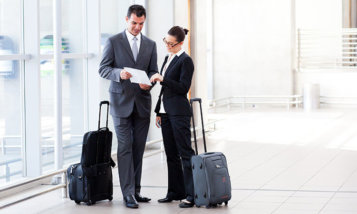In the world of global marketplaces, virtual offices, and where telecommuting is the norm, managing your employees’ traveling expenses is easier than ever (or at least it should be!). However, many small business owners are overwhelmed by the choices. You want to keep you, your business and your employee secure while traveling, but you also want to ensure your employee enjoys an approach that’s simple and easy to use. As the employer, you have some great tools at the ready to help make traveling expenses easier.
Consider the following items and tips for easier AP/AR, invoicing, budgeting and secure payments:
- Give the employee a concrete expense item list. Your employee shouldn’t have to guess how many meals per day they’re allowed, what the cap is, or whether or not springing for the extra luggage cart will be coming out of their pocket or not. Every employee should be given an updated list of acceptable expenses while traveling including amounts. Check the list regularly so that it’s current, and encourage employees to contribute input (anonymously if they wish).
- Virtual credit cards. It can be dangerous to give employees credit cards—not necessarily because they’ll abuse the privilege, but because credit card fraud from merchants is on the rise in the US and around the globe. With virtual credit cards, you can assign your employees a set limit and create your own termination date. Even better, wherever the card is used online, the merchant won’t get your “real” credit card number.
- Utilize electronic accounts payable. Are you still relying on traditional hard copies for A/P and A/R? Upgrade to an electronic format to save money, time, reduce double work and increase security. The more your employees travel, the more A/P and A/R will be coming your way. Choose a system that puts everything in one central “hub” where you and your employees (if you wish) can upload, download, update and stay on track.
- Get all employees on the same scan and save receipt tracker. This might be part of your greater electronic A/P system, or maybe you prefer one of the many apps that lets you snap a photo of receipts, store them and sort them. No matter how you scan and save receipts, having an established system where you can easily access copies of the “real receipt” can be a big money saver come tax season.
- Use hotel direct billing. Nothing is more stressful than your employee arriving at their hotel after a long flight only to find a problem with check-in. Hotel direct billing lets you provide credit card authorization prior to an employee’s arrival, and it’s sent back to you for confirmation. This minimizes stressors and financial issues while showing your employee that you care about their safe, seamless travels.
- Make use of cloud storage. Snapping photos of receipts and relying on virtual credit cards for safer transactions are both key, but what about bigger invoices (like the several pages that can accrue when an employee is at a hotel with room service for weeks!)? Having cloud storage where you control administrative rules lets employees scan and upload larger documents with each. Technically, you can do this with apps as well, but for bigger invoices you might find cloud storage to be an easier solution. If you don’t already have an established cloud provider, check out the numerous free options including Google Drive.
- Discourage employees from using personal cash/card payments. This is often the easiest solution when you don’t have an established travel protocol in place, but it’s a slippery slope. Asking or expecting employees to pay their own way, even if they will be reimbursed, puts a dent in the employee-employer relationship. Plus, what happens if there’s an issue with repayment?
Employee traveling expenses shouldn’t be messy or time-consuming. With tools like virtual credit cards, cloud storage and receipt trackers available, it can and should be an integral part of business where the only “bumps” are with the occasional turbulence. Having a protocol for travel expenses keeps your business running smoothly and your employees happy while on the road or in the air.



